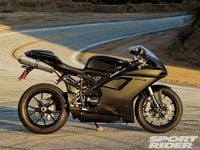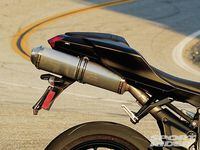Emissions Anger
I always see in response to horsepower and emissions questions that it's the U.S. emissions and noise restrictions on bikes that show decreased numbers on a dyno. Well I lived in Europe for three and a half years and noise and emissions restrictions are stricter there than in the USA. It would be nice to have a real explanation than to try and pass it off as if the U.S. is the leader in emissions reduction. If that was the case why is it in the U.S. you pay more emissions tax on a new car than an old clunker? To wrap this up: European emission and noise restrictions are far more strict than in the U.S. and please don't try and rebuttal with the fact of how many two-strokes they allow because anyone with knowledge will know that your oil mix products are not petroleum based as long as you're not buying it from a mom-and-pop gas station.
Cameron Zenga
Cedartown, GA
The emissions standards for hydrocarbons (HC), carbon monoxide (CO) and nitrogen oxides (NOx) are indeed stricter in Europe than in the United States if you look at the numbers alone. Here in the USA, the Tier 2 levels that went into effect in 2010 for motorcycles over 280cc call for maximum limits of .8g/km (grams per kilometer) combined HC and NOx, and 12g/km CO. Euro 3 standards for motorcycles over 150cc, which went into effect in 2006, have limits of 0.3g/km HC, .15g/km NOx and 2.0g/km CO. However, the test methods are significantly different, and this makes the standards much more similar than the numbers alone would indicate. When the EPA released the Tier 1 and Tier 2 standards in 2004, it stated that “the 2006 EU HC and NOx standards are roughly comparable to and perhaps somewhat more stringent than the California Tier 2 motorcycle standards effective in 2008.”
The big difference between Europe and the USA, and the cause of the discrepancy in horsepower levels, is in the noise emission standards. Both the EPA and the European standards call for an 80 dBA maximum sound level, but again the testing procedure is different — and in this case, significantly. In Europe, motorcycles must accelerate at full throttle from a set speed of no more than 30 mph in second gear, past a microphone. The microphone is set 25 feet away from the line of travel, such that the motorcycle passes perpendicular to the microphone 33 feet after acceleration starts. The EPA test procedure has the microphone further away at 50 feet, but the speed is such that the motorcycle passes the microphone in second gear at an rpm that (for motorcycles over 675cc) is 55 percent of maximum rated rpm — which refers to the rpm at which the engine makes peak power. Consider the difference: 30 mph in Europe compared to roughly 60 mph here in the USA. Even though the actual level is identical in the two standards, it’s much more difficult to meet that 80 dBA maximum here than in Europe.
Manufacturers can meet the different noise standards in a number of ways, but we generally see one of two methods employed. The images at above left show the U.S. and European versions of the Ducati 848 EVO; you can easily see the difference in the mufflers, with longer canisters on the U.S. 848 to help meet the noise limits here. What we are seeing more commonly, however, is that manufacturers lower the maximum rated rpm within the ECU, which in turn lowers the speed at which the sound test is conducted. Note again that outright maximum rpm (where the rev limiter cuts in) is not changed, but the engine speed at which peak power is made is significantly lower. The dyno chart below shows as an example the difference between our ‘08 Kawasaki ZX-6R in stock form and derestricted to its full European-spec output.
While some countries do have an emissions tax on new automobiles, the U.S. is not one of them. In any event, carbon taxes generally address CO2 output, which is a different matter entirely; in the U.S., this is addressed through fuel economy standards. And finally, I’m not sure the point you’re trying to make about two-strokes, but neither the EPA’s Tier 2 nor the Euro 3 standards distinguish between two-strokes and four-strokes; motorcycles are separated by displacement only and must meet the same limits.
Got a question?
** **The Geek
831 S. Douglas St.,
El Segundo, CA 90245
or e-mail srmail@sorc.com













/cloudfront-us-east-1.images.arcpublishing.com/octane/YMWAIPIPSJAOXOU3QMJMGH37OM.jpg)


/cloudfront-us-east-1.images.arcpublishing.com/octane/EJ6KZRGAYBCVXNL2PJXL37UVWQ.jpg)
/cloudfront-us-east-1.images.arcpublishing.com/octane/AAN4TI76M5H5JMUVEIGASWXBDU.jpg)
/cloudfront-us-east-1.images.arcpublishing.com/octane/P3RXD2UCPFF37CMB7CHPVKXORY.jpg)
/cloudfront-us-east-1.images.arcpublishing.com/octane/VZEG2EJI2RDFZNHLRZMU56MD3Q.jpg)
/cloudfront-us-east-1.images.arcpublishing.com/octane/GVJQO5FFOFBWNGODOBRB4FBAW4.jpg)
/cloudfront-us-east-1.images.arcpublishing.com/octane/BIVAK2SFIBDJJM25E7I5VU2FJE.jpg)
/cloudfront-us-east-1.images.arcpublishing.com/octane/CH5VX52UG5CFHOVH5A6UYEFWWA.jpg)
/cloudfront-us-east-1.images.arcpublishing.com/octane/ZVGJNGZRU5C33N7KN23BBFKSC4.jpg)


/cloudfront-us-east-1.images.arcpublishing.com/octane/CZ5OM3E43ZEXJHY7LCYXCHLIKI.jpg)
/cloudfront-us-east-1.images.arcpublishing.com/octane/DF5T4K5KPZFJXFCTGPYR77PKJM.jpg)
/cloudfront-us-east-1.images.arcpublishing.com/octane/RMCT2KVQBJHBZMRTSLOVPMOILU.jpg)

/cloudfront-us-east-1.images.arcpublishing.com/octane/K45KB2XHQVA65DX7VN4ZSMT2BI.jpg)
/cloudfront-us-east-1.images.arcpublishing.com/octane/FNHXQQ56BRD7TO4YIJ453PNG2M.jpg)
/cloudfront-us-east-1.images.arcpublishing.com/octane/OIKJC4JA3ZH7BMKUGWYKBIY5FA.jpg)
/cloudfront-us-east-1.images.arcpublishing.com/octane/MT2SAEWY6FDXFBYSLDE3AEFDTM.jpg)
/cloudfront-us-east-1.images.arcpublishing.com/octane/66UPKPYVURBPRCP5HXSN56MEMM.jpg)
/cloudfront-us-east-1.images.arcpublishing.com/octane/EOREGDSRKFDCRJC6K3EDVHBGCE.jpg)
/cloudfront-us-east-1.images.arcpublishing.com/octane/42RF63Q3LVCMBP3DGTWXFYSMOA.jpg)